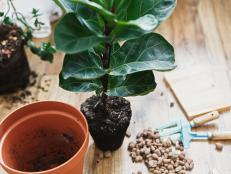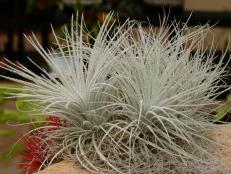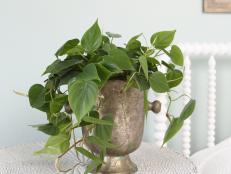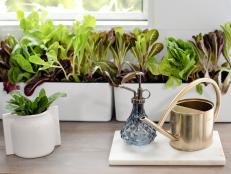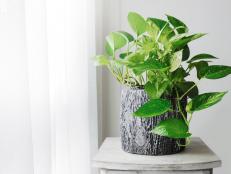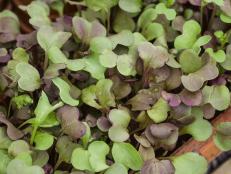Growing Bromeliads: How to Care for Bromeliads
These exotic tropical plants are easy to grow if you give them what they need, and they make baby bromeliad plants you can share with your gardening buddies.
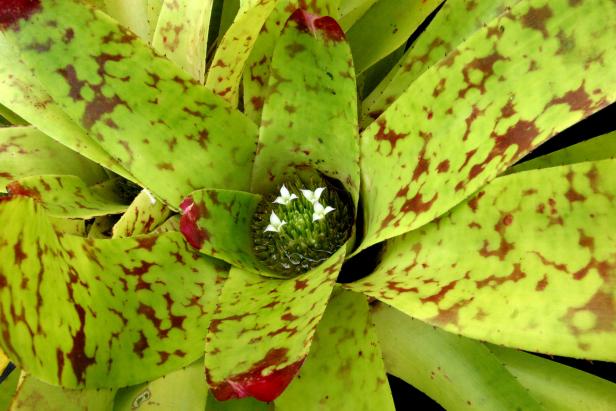
Dr. Phil Nelson for Marie Selby Botanical Gardens
A native to Brazil, marbled bromeliad (Neoregelia marmorata) boasts light green leaves with striking red markings on top and bottom.

Bromeliads are gorgeous tropical plants with striking foliage as well as flowers.
They can bring a touch of balmy, sun-washed climes to your home. Bromeliads are fairly easy to grow and care for, if you give them the conditions they need. They have showy flower displays, and beautiful, strap-shaped leaves in red, green, purple, orange and yellow with striking bands, stripes and spots. They’re a little bit of rainforest you can grow at home as a houseplant.
Generally, growing bromeliads is simple if you give them the conditions they need. Learn how to care for bromeliads and propagate these striking plants.
Bromeliads 101
There are more than 3,000 species of bromeliads categorized into around 75 genera, and they come in a huge variety of colors and textures. They’re native to Africa, Central and South America, the Caribbean, and the southeastern United States. Many bromeliads are epiphytic, meaning they get nutrients from their leaves, using their tiny root systems only to anchor them to trees or rocks. Others are terrestrial, growing in soil. They’re in the same family as Spanish moss and pineapples.
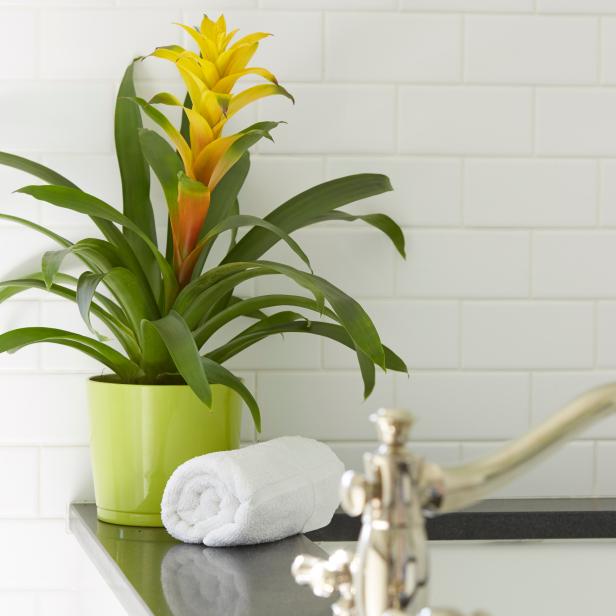
CostaFarms.com
You can give any room in your home a splash of calypso color with a tropical bromeliad such as this guzmania bromeliad, which blooms in clusters of showy red, orange, yellow, purple and white flowers.
Bromeliads live for two to five years. They’re one of those plants that blooms once when it hits maturity, and then slowly dies off as it puts all its energy into producing new plants, called pups. Bromeliad blooms last up to six months, so you get a long-lived bloom for the plant’s lone flower show. And once the bloom dies back, you’ll get new, baby bromeliads.
Botanical Name: Bromeliaceae
Common Name: Bromeliad
Hardiness Zones: 9 to 11
Bloom Time: Blooms once in its lifetime
How to Grow Bromeliads
Most of us buy a bromeliad at a nursery, or we’re growing the pups from a mother plant. Here’s what you need to know if you’re growing bromeliads.
Light
Bromeliads’ light needs vary by the type. Some can take full tropical sun while others thrive in filtered light. The best place for an indoor bromeliad is by a bright window that faces east or west.
Soil
Bromeliads like fast-draining potting soil. Orchid mixes, charcoal, and soil-less potting mixes work well. Epiphytic bromeliads can be grown as air plants, mounted to boards or logs with no soil needed.
Water
Bromeliads’ leaves form a cup at the plant’s base that catches and holds rainwater. To water a bromeliad, mimic the effect of a tropical rain by pouring water into the plant’s cup (also called a vase.) For indoor bromeliads, be sure to let the cup dry out before refilling or the water can become stagnant and rot the plant. Water the soil, too, but let it go dry to the touch between waterings.
Temperature and Humidity
Bromeliads thrive in temperatures between 65 to 70 degrees, but they’re tolerant of temperature variations. When growing bromeliads, don’t expose them to temperatures lower than 40 degrees. They do best indoors with humidity levels between 40 and 60 percent. To increase humidity, set bromeliad’s pot in a saucer of gravel filled with water. Make sure the bromeliad’s roots are not submerged, or the plant might get root rot. In many climates, you can take them outdoors in spring and summer for a break from the rigors of being a houseplant.
Getting a Bromeliad to Bloom
Most of us buy bromeliads at a nursey, already blooming. But if you’re working with a plant that hasn’t yet bloomed, you may need to put some effort into getting it to flower. Give it warmer temperatures, 75 degrees or above.
And here’s another tip for getting a flower, faster: Put the bromeliad in a paper bag (pot and all) along with a ripe apple, seal it up, and leave it for a week. The apple releases ethylene gas as it decomposes, and that gas promotes the formation of a flower bud. The plant should blossom about six weeks after it has been removed from the paper sack.
Fertilizer
Bromeliads aren’t heavy feeders. During growing season, feed monthly with a liquid houseplant fertilizer diluted to half-strength and poured on the soil. For epiphytic bromeliads, spray a diluted liquid fertilizer onto the leaves several times during the growing season. Don’t put the fertilizer into the cup, as it could burn the plant or cause algae to grow in the pooled water. Do not fertilizer plants in the winter when they’re dormant, or when they are in bloom.
Propagating Bromeliads
Bromeliads only live three to four years, but they make baby plants. Free plants! You can propagate your favorite bromeliads from those offsets or pups. When the pups are about half the size of the parent plant, and start forming roots, cut them away from the parent and pot them up separately. Take care of them, and you’ll have plenty of new plants to enjoy.
Varieties of Bromeliads
Here are some bromeliads to check out.
Guzmania (Guzmania spp.) is the most common houseplant variety of bromeliad. It’s the one you’ll see most often in nurseries and big box home improvement store garden centers. Guzmania blooms in clusters of showy red, orange, yellow, purple and white flowers. Their height varies by species, but they get as tall as 2 feet.
Neoregelia (Neoregelia spp.) are shorter, stay under a foot tall, and are not as showy as other varieties. Their blooms are tiny, but they often have gorgeous variegated foliage that gives lots of color.
Vriesea has spectacular flower spikes and gorgeous variegated foliage. They produce wonderfully weird flat bracts with tiny blossoms on them.






